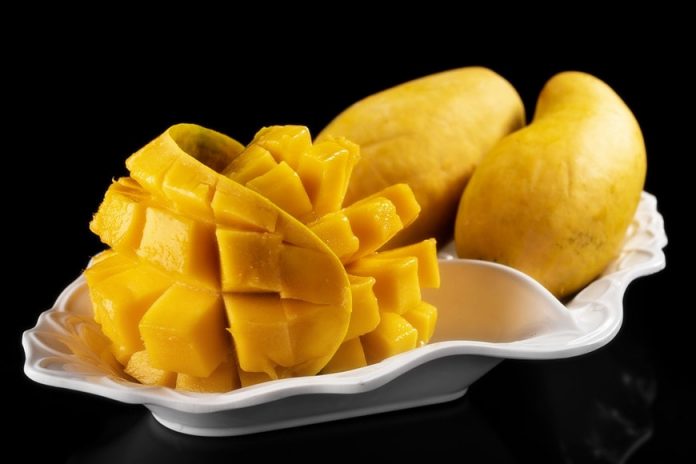Mango is a juicy stone fruit known for its sweet and tart-like flavor. If your dog has a taste for tropical fruits, he will certainly find mangoes pleasing.
Can Dogs Have Mango?
Yes, dogs can have some mangoes every now and then. This fruit is safe for our pets as long as you serve it without the pit. The pit is quite dangerous for dogs because it can become lodged in their intestinal tract.
Are there any other risks in giving mango to your dog, aside from the pit or the seed? In this post, we’ll take a look at the other causes of concern in offering this fruit to your pet. Before that, it helps to first know the benefits of mango for dogs.
Benefits of Mangoes for Canines
It helps in digestion. It has enzymes that can break down protein. These enzymes can be helpful in cleaning your dog’s stomach and intestines. Your dog could benefit from the fibrous nature of mango when he is having a hard time defecating. Aside from that, mangoes also have good fiber that reduces constipation. One whole mango weighing around 336 grams provides as much as 5 grams of dietary fiber.
It is good for the vision, skin, and coat. Mango is one of the best sources of Vitamin A. One whole mango provides 3,635.5 IU of Vitamin A. This fat-soluble vitamin promotes eye care while keeping your dog’s skin and coat healthy. Vitamin A is also important for the proper function of Fido’s muscles and nerves.
It helps calm the nerves. Mangoes can help you sleep at night and it can serve as a natural sleeping aid. This is due to its bioactive magnesium. There are no guarantees that our furry little friends will in benefit the same way but there is nothing to lose in trying. After all, mango is a safe treat for canines.
It is rich in flavonoids like the beta and alpha-carotenes. Beta-carotene is known for its antioxidant activities and helps convert Vitamin A according to its needs. Alpha-carotene, on the other hand, is converted to the body into Vitamin A. These flavonoids play a crucial role in many aspects of a canine’s immune functions.
It helps improve the brain function. Mangoes have Vitamin B6, which is essential for maintaining and enhancing the brain function. Vitamin B6 or pyridoxine works as a coenzyme in the dog’s body. It helps in metabolizing the amino acids in your dog’s body.
It supports a healthy immune system. Dogs can produce their own Vitamin C by synthesizing ascorbic acid from glucose in the liver or kidneys but this is not always the case especially for senior dogs. They are no longer as efficient as younger dogs in producing this vitamin. Therefore, they are more prone to certain diseases. Mango is a rich source of Vitamin C, with as much as 60.1 milligrams for every cup.
How to Serve Mango to dogs
Before peeling the mango, it’s important to first wash them thoroughly. This is to make sure that they are clean and there is no bacteria contamination.
You have two different options for cutting the mango. The first one is to cut the fruit into strips. Starting from the stem, make a cut from the center on both sides. Use a sharp knife to slice the flesh then scoop it out in your dog’s bowl.
Another way is to cut them into cubes. Like the first method, slice the mango in halves first. Then go on with parallel cuts to the side. Then create a nice grid using a sharp knife. Serve by shaving the big chunks onto your dog’s bowl.
When doing this, be careful not to pierce the skin. Actually, the skin or the peel of mango is edible. However, it’s still better if you remove it before serving the fruit to your dog because it is quite hard to digest for dogs.
What Are the Best Types of Mangoes for Dogs?
Did you know that there are more than 500 varieties of mangoes? Some cultivars can be very sweet while others can be extremely sour especially when unripe.
The Alphonso cultivar, the most popular and called the “king of mangoes” can be a good choice for dogs. It has a pleasant sweet taste and fibreless pulp.
Aside from Alphonso, other sweet mango varieties are the Mahachanok, Spirit of ‘76, Valencia Pride, and the Indian’s raspuri.
When picking a mango for your buddy, you can use your sense to tell if it’s ripe. The ripe mangoes should feel slightly soft to the touch. They should be full and plump. If a mango is flat, there’s a chance that it’s stringy or under-ripe.
It’s not advisable to look at the color alone since there are many different varieties of mango. They are mostly yellow but some are green, some are orange, and some are red.
Why the Pit is Dangerous to Dogs
The pit of the mango is a choking hazard to dogs. It is large enough to cause a foreign body obstruction. In some cases, dogs throw it up but in most cases, it gets lodged in their stomach and that requires surgical removal.
It can pass through without difficulty but there is also a possibility that it could get stuck in your pet’s digestive tract. Remember, the pit is an indigestible object.
Are mango pits poisonous? Contrary to myth, the pit is not toxic to dogs. Almost all fruits contain traces of cyanide but it will take huge amounts for it to affect anyone, including your dog.
What’s more concerning is the urushiol oil found in the mango skin. It is the same allergen found in poison ivy and it can affect anyone who pets your dog in the event that it dwells to his fur.
What to Do If Your Dog Ate a Mango Pit?
Do you suspect that your dog has ingested a mango pit? Even if you’re careful when feeding your dog, it is possible for him to find a pit and eat it. He could get it from your backyard, especially if you have a mango tree or from a compost pile.
The most common sign to keep an eye out for is if your dog started coughing and gulping. More often than not, canines also refuse to eat and drink anything when something got stuck in their intestines or esophagus.
In case this happened, it is best to contact your veterinarian immediately. If you are not sure if your dog ingested a mango seed, consider getting an x-ray or an ultrasound first.
Your vet can safely remove the pit from your dog’s body. If the pet is still in the esophagus, the vet can use a forceps to get it out. If it got stuck in the intestine or in the stomach, your vet will perform surgery.
There are dog owners who want to avoid surgery and use natural laxatives to get rid of the pit. A mixture of pureed squash and flaxseed steeped in hot water can help slide out the seed.
Some add a 3% Hydrogen Peroxide to the mixture to force a dog to throw up. It’s also acceptable to add a small amount of smoked fish or cooked liver to add flavor to the mixture.
While this method works for some, there is no assurance that it can be effective on your dog. Don’t attempt to remove it yourself or induce vomiting at home without the guidance of a vet. It can be pretty risky to force any foreign body back up.
Is the Sugar in Mango Bad For Dogs?
Mangoes contain a lot of sugar. They are ranked as the third most sugary fruit, next to dates and grapes. One whole mango contains 28 grams of sugar.
The naturally occurring sugar in mango is not as bad as processed sugar but it’s still best to limit your pet’s mango intake, since this fruit is still high in carbohydrates.
Dog-Friendly Mango Recipes
Mango Chicken Dog Cookies
Do you like giving cookies as a treat to your pet? Spice things up by giving something extraordinary this time, like a cookie made of mango and chicken. This treat has a nice balance of flavors, as the mango gives it some sweetness while the chicken makes it savory.
- Mix 4 oz. of cooked boneless chicken and 1/2 cup of old-fashioned rolled oats in a bowl.
- Add in 1 cup of chopped mango, 3/4 cup of whole-wheat flour, and 1/2 teaspoon of ground cinnamon.
- Crack in 1 egg to moisten up the mix.
- Knead the dough then form a ball.
- Transfer on a floured surface then roll it at around 1/4 inch thick.
- Cut using a cookie cutter of your preference.
- Place on a baking sheet lined with parchment paper.
- Bake for 15 minutes in a preheated oven at 350° The cookies should have a nice golden color when it’s done. Transfer on cooling racks before serving to your pooch.
Dairy-free mango sorbet
Got a lactose-intolerant dog? He might be missing out on delicious treats like ice cream and sorbet because of the dairy. What’s the solution? Make your own dairy-free treat! This mango-infused dessert is not just for dogs. You can make some for yourself too.
- In a blender, put 2 peeled ripe mangoes, juice from 1 lime, juice from 1 orange, and 1/2 cup of unsweetened almond milk.
- Keep blending until you get a puree-like consistency.
- Pour the mixture in a shallow tray. Leave in the freezer overnight.
Tropical Mango Coconut Milk Dog Shake Smoothie
Mango is one of the best fruits for making smoothies. The added yogurt and coconut milk make this smoothie creamy and healthy. For this smoothie, it’s best to use Greek yogurt since it does not contain too much lactose.
- In a blender, toss in 1/2 cup of sliced mango, 1 cup of coconut milk, and 1/2 cup of plain yogurt.
- Add in 1 teaspoon of honey.
- Put 1/3 cup of ice and 1/3 cup of water.
- Blend for 30 seconds.
Conclusion
Mango is a nice treat for canines as long as you only serve them the flesh. It’s not just delicious but also loaded with vitamins and minerals.
You can definitely give it as it is but it’s much better if you use the fruit for making healthy snacks for your doggie. As we suggested above, mango is the perfect fruit for making a tropical smoothie and sorbet for Fido.























